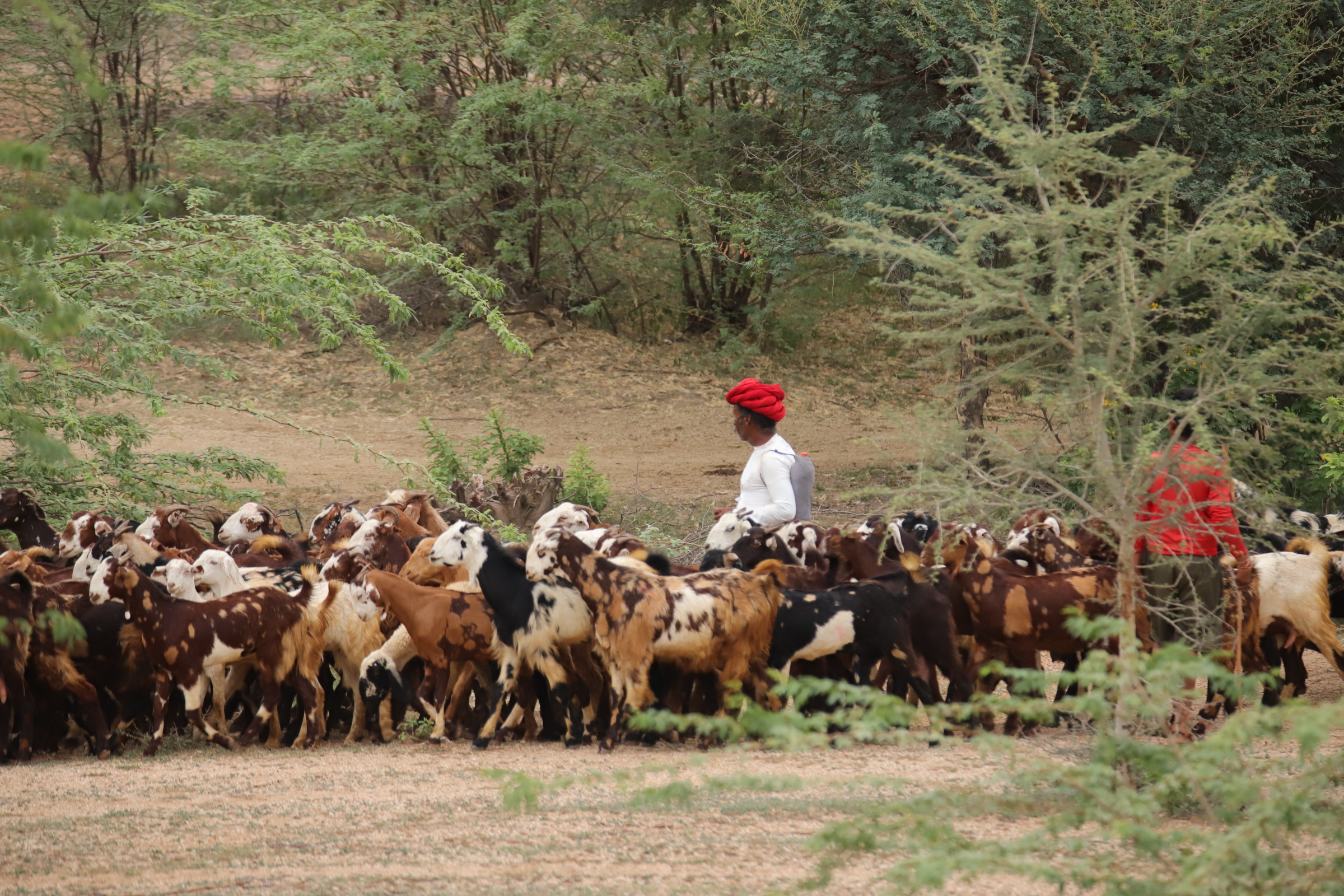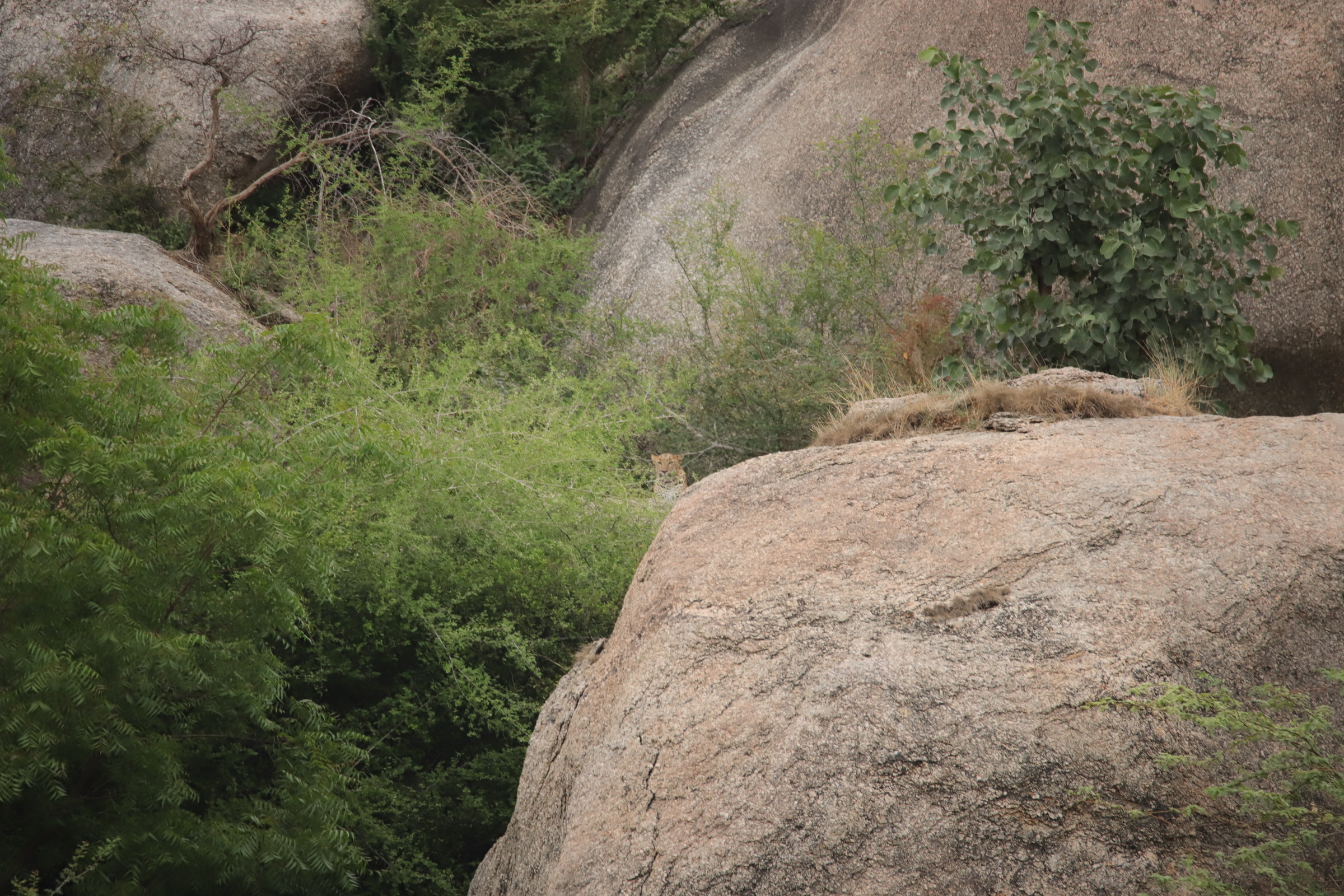THE BERA BOND: SHEPHERDS & LEOPARDS
-A.S Bishnoi and Shakti Bishnoi
Watch a photoslideshow on the village Bera
Leopards are said to be one of the toughest animals to spot, and contrary to popular belief, tigers are actually easier to meet. Bera is not just home to a few leopards
who have lost their way, the forest and its surrounding area is teeming with the spotted feline. Spotting the spotted feline can be a breeze if you visit Bera, Rajasthan. The small village and its surrounding forests and hillocks of the Aravallis are a heaven
to uncountable leopards.
Though village Bera is famous for leopards, there are other animals to be seen here. The faunal population mainly includes crocodiles, Nilgai,
Hyena, Jungle Cat, Indian Grey Mongoose, Sloth Bear. The place is also rich in avifauna with many migratory birds coming here. Birds like, Owl, Osprey, Egret, Pond Heron, Indian Robin, Black Shouldered Kite,Parakeet, Common Sandpiper, House Sparrow, Sarus
Crane, Large Cuckoo Shrike,Pelicans, Ruddy Shelduck, Greylag Goose, Pelicans, Asian Open bill Stork,Common Sandpiper, Grey-Headed Canary fly-catcher, Indian pond heron, blackibis, Red Throated fly-catcher and oriental magpie robin could all be seen.
Unknown by both locals and tourists, the wildlife enthusiast can go wildlife spotting freely, but with caution, as the area is pretty remote and secluded. BERAis
very accommodating – if luck persists you get to see the leopards just sitting on the rocks and sunbathing for an hour or so just posing for the perfect photo opportunity.

DUSK SAFARI AT BERA
Over two safaris during our two days stay at Bera, we were fortunate enough to spot a mother leopard and one male leopard. As the sun set and they walked into the dark
of the forest, my guide pointed out to us two eyes in the distance trained on the mother like two diamonds shining in the spotlights trained on them. They were the shining intense eyes of a leopard on a peak. Even from a distance,they shone like stars.
During our first safari, we were checking the few hillocks wherein these leopards have their caves, when our driver cum guide,spotted a female climbing down the hillock
and informed us, but we couldn’t even spot the location where she was sitting, as the rocks make a perfect camouflage for them. Though it was a short sighting we were really thrilled. We waited for the next one more hour to spot them closely. It rained and
we were waiting under a tree with umbrella to protect my camera and lens as we were exposed to the rain. We waited till final rays of sun settled to see her cubs. But she sat on the rocks for almost forty-five minutes giving us time to capture images of her
and her cubs were not in mood to come out and give us images. The forests are also home to hyenas, hares, foxes and birds like pelicans, greylag geese, robin accentors,demoiselle cranes, bar-headed geese and Indian partridges, and many more.
All safari organizers proudly mention of a 100 per cent record of sightings of leopard for their esteemed guests. In spite of such a unique presence of wildlife, there
is an area of concern for the leopards of BERA. The construction work going beside the hillocks for the double railway track between Jaipur and Mount Abu as well as the North-West Express corridor connecting North to JNPT are major causes of worry.
This may result in these leopards shifting their bases from here to some other locations due to the excessive disturbances which will occur due to the expressway.
DAWN SAFARI AT BERA,
The shrill whistle of a distant locomotive pierces the tranquil morning air. There is a momentary silence among the men who huddle around a dying fire, inching closer
every few minutes to make the most of the smoking embers. A dense fog hangs all around them, bringing visibility down to a few feet.
At first light, the landscape gains some semblance: On one side are open fields that lead to a few huts in the distance; a couple of hundred metres away on the other,
are granite outcrops, dotted with shrubs and cacti. It’s the cue for them to return to the Gypsies and get down to business. The lazy sun gradually spreads its warmth, as their hands emerge from the shawls, now holding binoculars and scopes. They train their
sights on the hill directlyin front of them and wait with bated breath to spot feline.
In the next few minutes,peacocks sound a warning and scatter from their vantage point, as leopard starts descend down the slope, ready for play with shutterbugs on a
brand new day. From behind them emerges a very graceful sun and its warmth soaking us in the crisp morning air. After a quick stretch, she settles down on a rock to get toasty, her thick winter coat resplendent in the sunshine. For the next hour, the trigger-happy
onlookers have their fill of photoshoot, before the wild cat retreats to the comfort of cave.
The promise of this glorious setting was enough reason for us to make our trip and make the netizens know about this place by writing this article. This was once an obsolete
village located around 140 km from Udaipur. The Jawai Bandh built in 1957 drew migratory birds such as the Greater Flamingo and Sarus crane, but it was the everlasting bond between the leopards and the locals that first brought the region into prominence.
This relationship that has blossomed amid a stunning setting is called the everlasting bond of humans and leopards in BERA. It’s a unique coexistence of human and wildlife, a shining example of harmonious cohabitation which is celebrated without sullying the
sanctity of Bera. While leopards can be found all the way from the Narali-Kumbalgarh area, north ofBera, to Mount Abu near the Gujarat border, it’s the 20 sq km around Jawai Bandh where around 55 of them have found a secure haven. It’s an unusual connect
between the felines and the Rabari community comprising shepherds and farmers. Almost 99 percent of their prey base is domestic livestock belonging to the Rabaris, who are believers of Lord Shiva. If you notice Shiva’s image, there’s even a leopard skin draped
around him. So the locals do not harm the leopards even when their animals are killed and think of it as an offering to God.
In fact, a few of them even refuse compensation for their animals that is offered by the forest department or local hoteliers. There has never been a case of poaching
or attack on humans either. According to a 2018 census, India has 12,852 leopards,up 60 percent from the 2014 estimate. However, their adaptability has made them omnipresent across various landscapes in India, leading to regular confrontation with humans.
The Wildlife Protection Society of India reported 653 leopard deaths across the country in 2020 and 171 so far this year.
The hillocks that dot the Bera region are then a secure refuge for the leopards, who are known to descend after sundown, go about business under the cover of darkness,
before returning to the heights. The locals on their part keep out of the way when theleopards are out on the prowl. However, they are also known to share space on occasions without any conflict. For instance, a Shiva temple on Perwa hill is frequented by
villagers, who’ve often encountered the leopards on their visits. Local lore also features a priest, Maharaj Amar Nath, who dwelled alongside the leopards, much like the rest of the populace does today. That in turn has led to a flourishing leopard population
and a rush of wildlife lovers over the last few years.
You don’t really expect a leopard in this landscape, let alone spotting four together, which is a very rare phenomenon. If you go to Kabini for instance, you’ll be lucky
to spot just one up a tree. It would all have been very different, if not for concrete stepstaken a few years ago.

Concerns
There were 12 mines allotted in the area and another 144 in the pipeline. There was in-fact mining to be undertaken but locals opposition and government taking stern
action finally led to cancellation of all permissions. The next step to secure the area is to get it declared as a community reserve, given that a majority of it is private land belongs to the local villagers.
Recently, panchayats of three villages, Villar, Chamunderi and Lundara in Pali have unanimously agreed to form a community reserve. The proposal has been sent to the
state government and is awaiting approval.
However, other issues have emerged over the last few years with the area gaining popularity. Hotels and guesthouses have rampantly cropped up to cater to the tourist
influx,besides unregulated safaris that have little regard for rules or wildlife. Commercialisation is important for conservation, but it has to be responsible commercialization.
Further highlights are how over head electricity lines have posed a danger to the leopards. Besides, a railway line runs right through the area, which is currently being
expanded and is only going to get more busy in the days ahead. Over the years, domestic animals to a leopard and crocodile have been run over by the locomotives. It needs to be addressed. The 15 km stretch between Falna and Keshavganj is a deathtrap and
needs to be fenced. It’s only then that animals will use the underpasses that have been constructed. This is just the beginning for this region, so it’s a good time for the government to step inand do something about it.
Mrs Shakti Bishnoi belong to a farmer family, a mother, counsellor, ornithologist, wildlife
photographer, plant trees every year, marathon runner, nurturing butterflies since 2010(1300 butterfly
🦋 reared) , a silent observer and live in sync with the nature. She strives to increase green cover by
planting native trees.
Mr A S Bishnoi is an ornithologist, entomologist and passionate wildlife photographer. Both of them
have been contributing in Chilika bird census for one decade and have planted Pune city's first Sacred
Groove. He has planted 1500 trees during COVID and are alive.